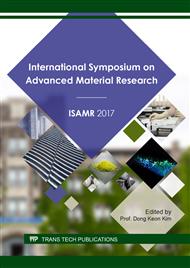[1]
A. Oliver, Thermal characterization of gypsum boards with PCM included: thermal energy storage in buildings through latent heat, Energ. Build. 48 (2012) 1-7.
DOI: 10.1016/j.enbuild.2012.01.026
Google Scholar
[2]
B. Zalba, J. M. Marin, L. F. Cabeza, et al., Review on thermal energy storage with phase change materials: heat transfer analysis and applications, Appl. Therm. Engin. 23 (2003) 251-283.
DOI: 10.1016/s1359-4311(02)00192-8
Google Scholar
[3]
A. Sharma, V. V. Tyagi, C. R. Chen, et al., Review on thermal energy storage with phase change materials and applications, Renew. Sus. Energ. Rev. 13 (2009) 318-345.
Google Scholar
[4]
F. Pitié, C. Y. Zhao, J. Baeyens, et al., Circulating fluidized bed heat recovery/storage and its potential to use coated phase-change-material (PCM) particles. Appl. Energ. 109 (2013) 505-513.
DOI: 10.1016/j.apenergy.2012.12.048
Google Scholar
[5]
H. L. Zhang, J. Baeyens, J. Degreve, et al. Latent heat storage with tubular encapsulated phase change materials (PCMs), Energy 76 (2014) 66-72.
DOI: 10.1016/j.energy.2014.03.067
Google Scholar
[6]
R. L. Zeng, X. Wang, H. F. Di, et al., New concept and approach for developing energy efficient buildings: ideal specific heat for building internal thermal mass, Energ. Build. 43 (2011) 1081-1090.
DOI: 10.1016/j.enbuild.2010.08.035
Google Scholar
[7]
R. Cheng, M. Pomianowski, X. Wang, et al., A new method to determine thermophysical properties of PCM-concrete brick, Appl. Energ. 112 (2014) 988-998.
DOI: 10.1016/j.apenergy.2013.01.046
Google Scholar
[8]
Y. P. Zhang, Y. Jiang, Y. Jiang, A simple method, the T-history method, of determining the heat of fusion, specific heat and thermal conductivity of phase change materials, Measur. Sci. Tech. 10 (1999) 201-205.
DOI: 10.1088/0957-0233/10/3/015
Google Scholar
[9]
F. Kuznik, J. Virgone. Experimental assessment of a phase change material for wall building use, Appl. Energ. 86 (2009) 2038-(2046).
DOI: 10.1016/j.apenergy.2009.01.004
Google Scholar
[10]
K. E. Omari, Y. L. Guer, P. Bruel, et al., Analysis of micro-dispersed PCM-composite boards behavior in a building's wall for different seasons, J. Build. Eng. 7 (2016) 361-371.
DOI: 10.1016/j.jobe.2016.07.013
Google Scholar
[11]
P. Gimenez, A Jove, C. Prieto, et al., Effect of an increased thermal contact resistance in a salt PCM-graphite foam composite TES system, Renew. Energ. 106 (2017) 321-334.
DOI: 10.1016/j.renene.2017.01.032
Google Scholar
[12]
W. Wu, X. Huang, K. Li, et al., A functional form-stable phase change composite with high efficiency electro-to-thermal energy conversion, Appl. Energ. 190 (2017) 474-480.
DOI: 10.1016/j.apenergy.2016.12.159
Google Scholar
[13]
G. Feng, K. Huang, H. Xie, et al., DSC test error of phase change material (PCM) and its influence on the simulation of the PCM floor, Renew. Energ. 87 (2016) 1148-1153.
DOI: 10.1016/j.renene.2015.07.085
Google Scholar


